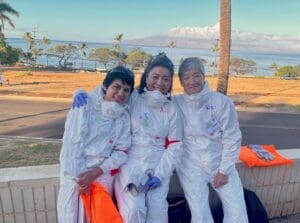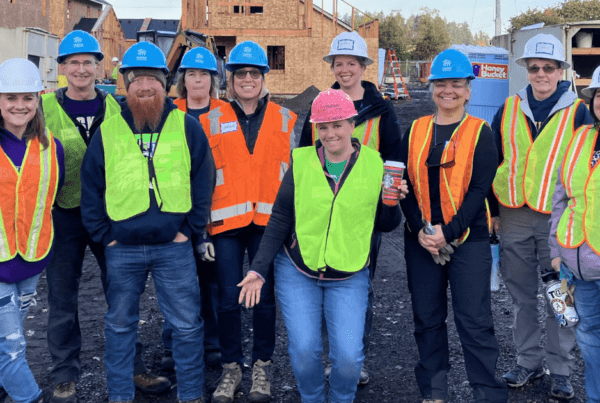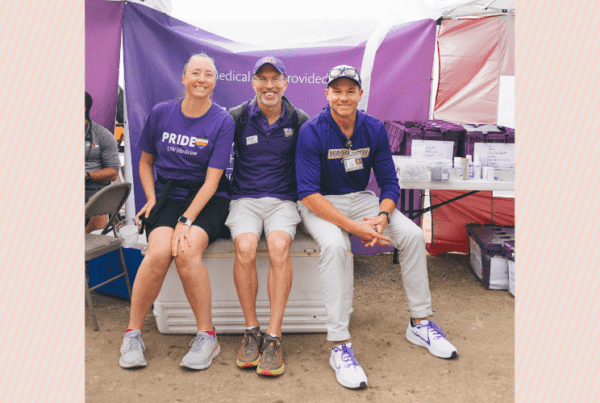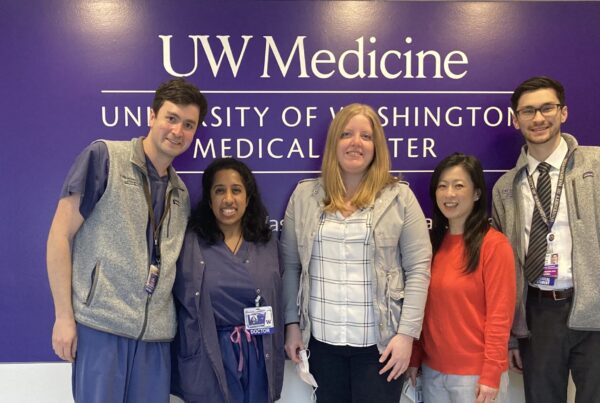Highlights | Making connections after tragedy
-
Volunteers from the UW and UW Medicine community travelled to Lāhainā to help with wildfire recovery and healing efforts.
-
They connected with survivors through cultural activities that inspired creativity and communication.
The devastating wildfires that started in Lāhainā, Upper Kula, Pūlehu/Kihei and Ka‘anapali on the island of Maui on Aug. 8, 2023, were some of the deadliest U.S. wildfires in the last 100 years. Though much of the world could only watch in horror from afar, one group of women from UW Medicine and the University of Washington took matters into their own hands, crossing the ocean to provide much-needed mental health services to the community.
Understanding why and how they did it makes more sense once you know more about Val Kalei Kanuha, MSW, PhD, associate dean for Academic Affairs for the University of Washington School of Social Work and Tracy Hirai-Seaton, MSW, LICSW, patient liaison and clinical analyst at UW Medicine who has been at UW for 25 years and was a graduate of the UW School of Social Work.
Figuring out how to help
Both Kanuha and Hirai-Seaton were born and raised in Hawaiʻi and still have close ties to the islands. Once the wildfire struck, Kanuha reached out to fellow social workers because she felt the need to do something — a sentiment felt by many.
“I think many of us, not only those who are from Hawaiʻi, but those of us with friends or family there, just felt so despondent about the situation and at a loss of what to do,” says Kanuha. “Many of us called our family and friends and donated money, but it just didn’t seem like enough.”
Listening, learning and acting
Kanuha started calling around to friends and colleagues in Hawaiʻi, asking what they really needed. With all of the trauma happening in Lāhainā, including people losing their loved ones, homes and their entire communities, many of the people she reached out to said that no one was dealing with the mental health issues experienced by the community — which is something that Kanuha felt she could help with.
It wasn’t exactly clear what they were going to do, but Kanuha and a group of clinical social workers from Seattle, mainly from the UW School of Social Work, took their first trip in October, staying for five days and working alongside volunteers from the Red Cross, FEMA and other organizations. And since it was still so soon after the fires, they pitched in wherever they could. Though Kanuha was happy with their trip and their efforts, she knew she wanted to go back, and quickly arranged to return in December.
This time, in addition to Kanuha, the group of volunteers included Hirai-Seaton; Antonia Alvarez, PhD, LMSW; Alice Cagampang Ryan, MSW, LICSW; and Aida Villeda Wells, MSW, LICSW, CCTSW. Representing UW Medicine, the UW School of Social Work and Portland State University, the diverse group had a clearer idea of what to do: They focused on the people who had been displaced to hotels, performing wellness checks where they went from room to room checking on survivors.
“We had a lot of really moving experiences,” says Kanuha.
Hirai-Seaton agrees, explaining that they went with a desire to focus on Native Hawaiian and Filipino communities because of the historical trauma and impact on Indigenous Hawaiians, as well as the immigration histories of Asian and Pacific Islanders in Hawaiʻi.
“Going in, we wanted to be culturally sensitive when speaking to people and do our work with no judgment and really do it from a trauma-informed perspective of being present,” she says. “We saw other mental health resource centers were waiting for people to come to them. We wanted to lessen the burden by bringing resources to people.”
Connecting culture with healing
As they traveled through Lāhainā they passed burned-down churches and other destroyed cultural heritage sites with the understanding that, though tourism will eventually return, some of these cultural, religious and Hawaiian artifacts are gone forever.
It was this realization and the discussions they had with folks in their wellness checks, that emphasized for Kanuha and Hirai-Seaton the importance of cultural connection as part of the healing process. They decided to host two cultural activities: one Native Hawaiian activity called ʻohe kapala, which uses traditional bamboo stamps to decorate pieces of cloth, and one Filipino activity, the parol, or creating tissue paper stars, a Christmas tradition in Filipino communities.
“‘Ohe kapala is a deeply cultural Hawaiian activity, which I think most of the survivors had never actually done before,” says Kanuha. “While it is a Hawaiian tradition, we had all kinds of ethnic groups come in and participate, and everybody was interacting together and also having a lot of fun.”
Kanuha says that the banter and laughter provided some much-needed levity, but it also broke the ice and created an opportunity to talk about the tough experiences with the wildfires. Kids talked about their feelings about having to move schools and adults expressed their fears and worries after being displaced from their homes.
“It would go from joyous to really deep moments of conversation, getting to the heart of what they needed and what they missed since the disaster,” says Hirai-Seaton. “It was just cycles of joy, loss, happiness and fear of what’s to happen next.”
Kanuha adds that their social work training helped guide their interactions in creating a safe space for people to talk.
“I really think it was something about our training and our values as social workers — I mean, my training is to meet people where they are and to serve people wherever they need to be served, and it doesn’t bother me, I don’t feel out of place in these kinds of settings,” explains Kanuha. “I think this is very particular to social workers, we’re not afraid of those kinds of ways of working, and I think that was what made our work effective.”
They also joined specially trained volunteers who were assigned to the burn zones to provide support for families who lost their homes and returned for the first time since the fires.
“That was one of the most moving, sad and also inspiring experiences of the trips; many families we spoke with were resilient and grateful for having survived,” says Kanuha.
“And we were there to talk and support them through that experience,” says Hirai-Seaton. “It’s something I’ll never forget.”

Ryan, Wells and Kanuha in PPE, getting ready to enter the burn zone.
What’s next?
When it comes to what exactly is next — that still isn’t totally clear.
“This is the start of a new generational trauma for this community that their kids and even their grandkids are going to be living with the effects of,” says Hirai-Seaton. “I don’t want people to forget about what happened in Lāhainā. I hear people asking, ‘Is it okay to visit?’ It is important to understand that it’s so tender there still.”
Kanuha agrees, saying, “The biggest advice I would give if you’re visiting is to follow the lead of whoever you are talking to — a server at a restaurant or the front desk person at your hotel. You must be more sensitive and vigilant about your behavior. We need people to come back, but we need them to come back in a different way.”
When discussing the future, Kanuha also talks about the possibilities of a new and exciting opportunity to help the community heal through a land-based site on 60 ocean-front acres that she’s been helping procure. She’s hoping the space in West Maui can be used as a place for wildfire survivors and others on the island to participate in trauma-informed Hawaiian cultural practices, with a focus on healing with the help of trained clinicians and Hawaiian cultural practitioners.
How can other people support recovery efforts?
Visit the UW Combined Fund Drive for more information on helping those impacted by the wildfires in Hawai’i.
Editor’s Note: This article, at the request of the interviewees, includes the traditional Hawaiian spellings for places and locations to honor the origins of the land and its people.



